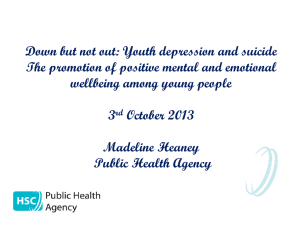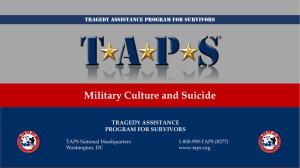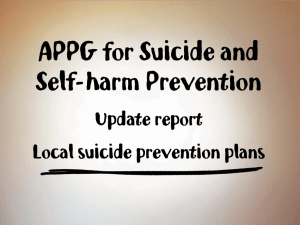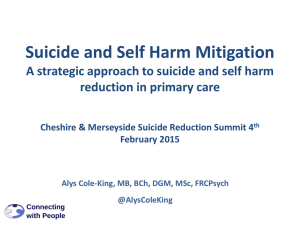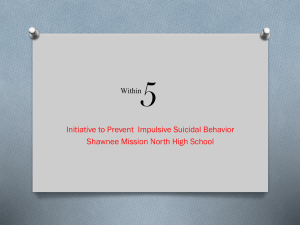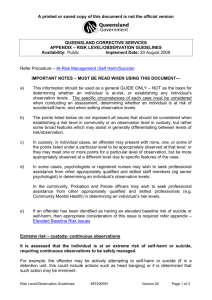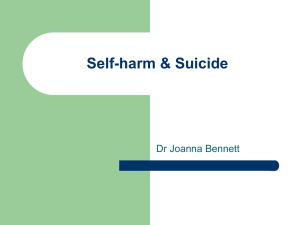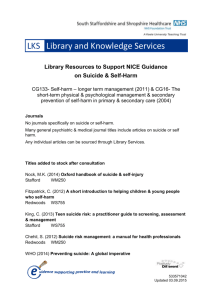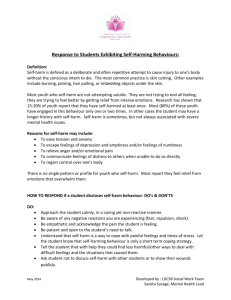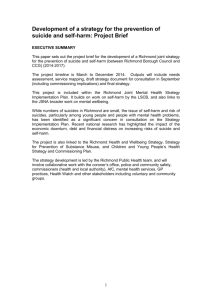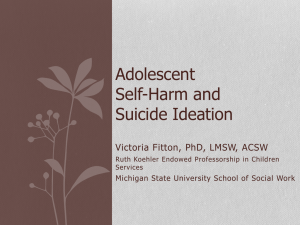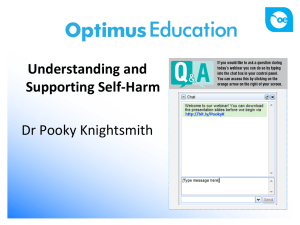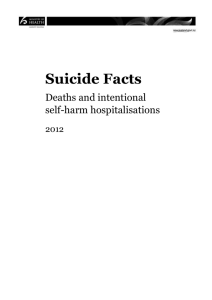Dr. James Irvine - Setting the Context
advertisement
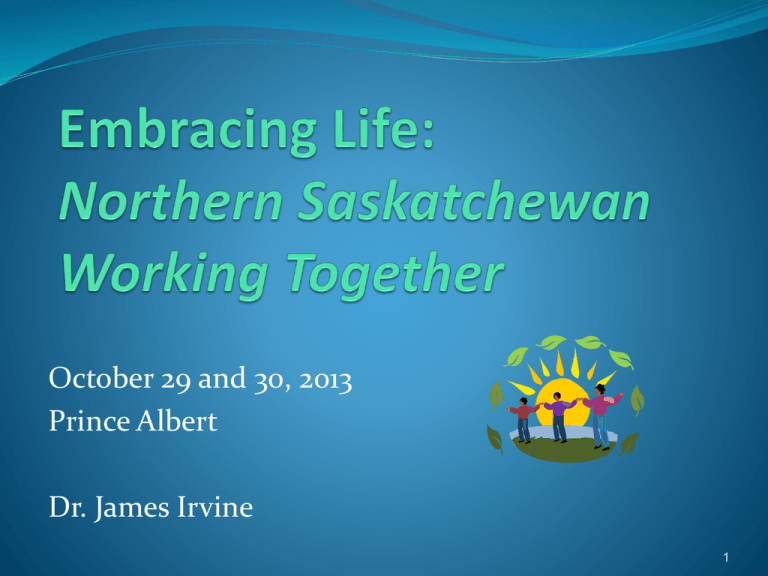
October 29 and 30, 2013 Prince Albert Dr. James Irvine 1 How Embracing Life workshop was developed The need for continued ACTION 2 What is Embracing Life? Ongoing action for suicide prevention starting with a 2-day North-wide action based workshop A starting point to develop action items to address suicide in every community in the north Community specific actions utilizing our strengths and resources most effectively Platform to provide input & plan action steps for reducing suicides and self-harm by health promotion, suicide prevention, intervention and post-vention Comprehensive & across organizations, governments and communities. 3 Why is this Important? A call to action to reduce suicides and self-harm We all have a role to play in suicide prevention – need for ownership, commitment and collaboration Building on our strengths Establishing North-wide supports Moving forward from previous work Suicide and self-harm are continuing issues in the north 4 Deaths by suicide Canada 2000-2007; and North Sask 2000-2009 * Hospitalization for Self-Harm North Sask and Sask 2002-2010 6 Hospitalizations for self-harm North Sask and Sask - 2002 to 2010 Death by suicide is the tip of the iceberg What lies underneath? The many faces of the same issues: Deaths by suicide The crisis: a symptom of underlying issues. Self-harm, assaults, injuries Emergency department visits and hospitalizations Mental health issues Unresolved grief, previous traumatic events, depression, substance / alcohol abuse, bullying Social issues Poverty, intergenerational trauma, cultural loss Things that determine our health = health determinants CPHO’s Report on the State of Public Health in Canada 2008, Addressing Health Inequalities From: Dahlgren G, Whitehead M (1993) Canadian Supplement to UNICEF’s THE STATE OF THE WORLD’S CHILDREN 2009, Aboriginal children’s health: Leaving no child behind The Balance Protective factors Risk Factors Risk factors versus protective factors Risk Factors: • Mental illness – depression, anxiety, substance abuse • Previous attempts – especially with highly lethal means • Precipitant e.g. stressful life event, social humiliation or disgrace, • Impulsivity • Family history – family communication / parental monitoring • Environment characterized by abuse and/or loss • Family or friends’ histories of suicides or self-harming • Sexual identity • Intergenerational trauma • Poverty Risk factors versus protective factors Protective Factors: • • • • • Social supports Sense of family cohesion School connectiveness Sports involvement Community engagement in rebuilding or maintaining their cultural continuity Risk Factors Individual influences Social risk factors Cultural & systemic risk factors Risk Factors: 1) Individual influences: one’s own psychological state, personality, mental / emotional health – Low self-esteem, depression, impulsivity, sexual orientation, substance abuse 2) Social: school, peers, community, parents, etc – Suicide by a friend or family member, sexual victimization, family violence, neglectful and unsupportive parents, social isolation 3) Communities, Culture and Continuity – Cultural identity, colonization, intergenerational trauma Suicide Continuum of Care •Minimizes the impact of a suicide on survivors; important for prevention •Policies and programs that enhance healing, mental, spiritual, social, & physical well-being PostVention Intervention •Early recognition, direct contact with the person involved, access to assessment and care Health Promotion Prevention • Provides coping and problem-solving for increased resiliency, reduced risk conditions 17 Deaths from heart attacks is decreasing in Canada the efforts of many people • • • • Members of the public knowing the signs and knowing CPR Emergency responders, primary care providers Specialists Life behaviour influencers – healthy eating, physical activity, education on smoking reduction, medical prevention management • Policy makers – e.g. regulations on smoking, food, etc to make healthier environments Promotion Prevention Intervention Rehabilitation Suicide and Self-harm • Awareness of signs and symptoms • Knowledge of what to do if you know of someone • Human services providers, schools, workplaces, communities • Where to seek help – crisis lines 811, • Screening through primary care sites for risks • Access to counseling and supports • Access to care • Post-event counseling and supports Promotion Prevention Intervention Postvention Whose Responsibility Is It To Reduce Suicide and Self-Harm? WE ARE ALL RESPONSIBLE!!! 20 Multiple actions at multiple levels - long-term – community driven Promotion Prevention Community Regional Northwide Provincial & National Intervention Postvention What has happened? NHSP – A Suicide Prevention Resource: Exploring Strategies for Northern Saskatchewan 2009 Northern Suicide Prevention Forum 2009 Suicide Prevention, Intervention and Post-Vention Training Health Line 811 22 What is currently happening? First Nations and Inuit Health Branch, SK Region Strategic Review Metis Nation – Saskatchewan Northern Youth Suicide Prevention National Aboriginal Youth Suicide Prevention Strategy Provincial Mental Health and Addictions Action Plan 23 What is currently happening? Saskatchewan Suicide Protocols for Saskatchewan Health Care Providers Suicide Prevention Policy for regional health authorities by March 31, 2014 Pre-Workshop Activities Matrices Training and Resource List Literature Review 24 How Will Embracing Life Be Effective? Building on work that has been done previously Background information collected Best practices, programs, gaps, resources, training Presentations meant to provide thorough information for participants Opportunity for ALL participants to provide feedback & input on: priorities, action items, gaps Break out sessions planned to obtain input from front line staff, community members, Elders, youth, agencies, organizations, etc. 25 How do we best come together and move forward for mental well-being? What approaches are required? Traditional approaches; conventional mental health; youth development; others. Thank you for attending, for your participation, your voice, your desire for change for a brighter future for our youth. 26 Embracing Life Committee So far, composed of representatives from: First Nations University of Canada Federation of Saskatchewan Indian Nations Health Canada Keewatin Yatthé Health Region Mamawetan Churchill River Health Region Ministry of Government Relations Ministry of Justice New North SANC Services Inc. Northern Human Services Partnership Northern Inter-Tribal Health Authority Northern Lights School Division Population Health Unit Prince Albert Grand Council 27


